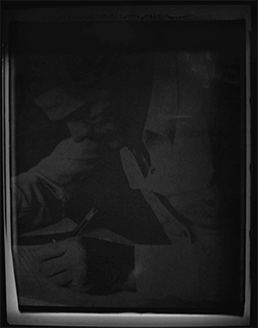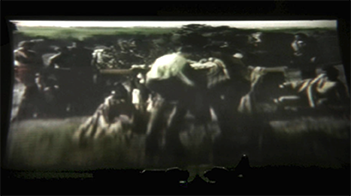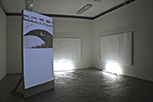John Di Stefano: Bandiera Nera
Sydney College of the Arts, Sydney, 23 January–21 February 2015Aleksandr Andreas Wansbrough
John Di Stefano’s works from 1997 to the present evince his fascination with the figure and work of Pier Paolo Pasolini. Bandiera Nera, his exhibition at the Sydney College of the Arts Galleries (23 January–21 February 2015),included only some of his work from his ongoing art practice exploring Pasolini. The works as exhibited exist by themselves, but together become a larger work, involving contact rubbings on paper, video projections, sound recordings and photography—all contained in four rooms. In conversation, Di Stefano told me that his exploration of Pasolini is more archaeological than archival. The concept of the archaeological seems to me to be fundamental to the work. The theme of the archaeological and its signification of remnants are ever present in Bandiera Nera. What follows is a reflection on the deeply personal explorations of Di Stefano’s works on Pasolini.
The exhibition is political and involves the contradictions of political action—Bandiera Nera, which translates as “black flag”, evokes both anarchism and fascism, and thereby paradoxically alludes at once to liberation and oppression. There are a number of ways this paradox plays out in the theme of the exhibition. Pasolini’s demise was at the same time a sign of resistance and a search for freedom, as well as the outcome of the oppression that he experienced at the hands of the extreme and extremist Right. In a more philosophical sense, we can be trapped by our emancipatory yearnings. The desire to change the existing power structures can be all consuming and ultimately fruitless. Indeed, projects of emancipation often become brutal and dangerous when implemented. The very notion of emancipation would seem to some, after the alleged demise of “grand narratives”, to be archaeological, even antiquarian, in the sense of revisiting the past. Approaching the installations in the exhibition, then, becomes both an affective and a conceptual enterprise, the nexus that constitutes something of the aura of the archaeological.
Upon entering a darkened room, the first in the exhibition, one immediately sees the light of the projection of Di Stefano’s Volgar Eloquio (2002; Figure 1). The projector conjures its mirage: hands pressing down onto the keys of a typewriter. The hands, via the mediation of machines—the antiquated word processor and the digital projector—relay a poem. The dark indentations on the projected page bespeak the suffering of Pasolini—a poet, essayist, writer, filmmaker, Marxist and homosexual. Indeed, while the hands are not Pasolini’s, the text—the poem—is. On the left side of the room, dark black–blue paintings hang, or rather Polaroid photographs that resemble paintings, entitled Tenebre (2002; Figure 2). They look like Rothkos (the ink of the photos runs like Rothko’s paint) but close up they prove to be photographs of Pasolini. Dark voids, where form emerges and disappears—they have something sacred about them, suggesting presence in absence and absence in presence. Then, more to the right, one notices a typewriter and long sheets of paper: Senza Parole (2005; Figure 3) is a work in conversation and also dialectical tension with the images of Pasolini typing. The typewriter is static, but there is a projection onto the page. The projection is of two dancing male figures, taken from Pasolini’s satirical and bleak comedy La Ricotta (1963). The dance is liberated, fun and homoerotic. It seems to contrast with the tortured, self-lacerating artist typing the poem, and indicates the connection between humour and critique which was so important to Pasolini.

Figure 1 (Left): Vogar Eloquio (John Di Stefano, 2005). Digital video projection. Senza Parole (2005). Digital video and mixed media. Figure 2 (Right): Tenebre (John Di Stefano, 2005). Polaroid photographic prints (42cm x 52cm each. Series of four images. Edition of 1). Photographs: John Di Stefano.
That is the first room. I step out and notice two large pieces of paper, rubbings taken from Antonio Gramsci’s grave, a figure that was as much an inspiration for Pasolini as for many other intellectuals. The pieces are split up and read “Gram/sci”, perhaps suggesting that his Marxism is a broken or cracked form of resistance, a monument to the past. However, monuments also actualise the past, and their disfigurement or decay often strengthens their aura, at once making them timeless and signifying their pastness. The division within the name of Gramsci invokes pathos, implying a sense of broken modernity but also strengthening an idea of resistance. The name can still be deciphered in its divided state. Political resistance today is hard to comprehend in a world after postmodern critiques of progress; yet the need to resist remains. The name and indeed the space is lit by a red light—invoking a sense of the red-light district, perhaps referencing Pasolini’s sensual resistance to fascism and capitalism, as well as signifying Marxism. Gramsci was imprisoned by the Fascists (and died probably because of the ill health that accompanied his imprisonment), and Pasolini was also arrested at times, and eventually killed, presumably by fascists. The red right evokes a sense of horror. After all, red is usually signified in horror films to indicate a moment of slaughter, and is the colour of blood. The use of red can then signify that Gramsci’s and Pasolini’s blood becomes a light in the darkness. There’s also something of the dark room, where images are developed. The split in Gramsci’s name thereby becomes a fracture where discourses and senses collide. The work itself is called Gram/sci (2013),which suggests a link between text and monument; the monument becomes textual as the text becomes physical, reproduced for continual signification and re-signification.
Figure 3: Senza Parole (John Di Stefano, 2005). Digital video and mixed media. Detail.
Photograph: John Di Stefano.

Figure 4 (Left): Theorem (John Di Stefano, 2005). Digital video, photography and mixed media.
Figure 5 (Right): Punto (John Di Stefano, 2013). Digital video. Photographs supplied by the artist.
As with museums and archaeological sites, the pieces, artefacts and artworks become interrelated, their meanings bleeding into one another. As one looks at Gram/sci,or up at the red light, one hears a voice echoing. The work, entitled Silence Please (2013), is an audio recording from the Pantheon in Rome. We hear the sounds of tourists jostling and hushed voices, and a recording of a voice instructing everyone to remain silent in five different languages. The work establishes a subtle sense of coercion as well as an experience of reverence. We are in a museum, amidst archaeological remains, hearing the movements of other human beings who have now, in the Derridean sense, become ghosts.
For me, hearing a disembodied voice recalls the voice of Dr. Mabuse in Fritz Lang’s The Testament of Dr. Mabuse (1933). In The Testament of Dr. Mabuse, the villainous voice and mind of Mabuse live on after madness and death—controlling and infecting others. The voice in Silence Please is not as hostile as Mabuse’s, but there is a sense that it is frightening, with a hypnotic red light beaming down.Control and power linger on, structuring our actions, however courteous the tone. It is not a totalitarian voice or an authoritarian voice, but it is a voice from on high, a voice that continues in our supposedly liberal and supposedly democratic times. The instruction of reverence almost contrasts with the sense of irreverence involved in the Marxist act of revealing power structures. Yet, on another, almost contradictory level Di Stefano is politely asking that we accord Pasolini a certain silence. By according Pasolini silence, we allow for an echo of Pasolini amidst the ruins. In that way, Pasolini ceases to be silenced. We can then pay attention to his words, his gestures, his presence. Di Stefano thereby places both Pasolini and Gramsci in the Pantheon so that they can live on.
Indeed, there is something living rather than dead about archaeology. Archaeology conjures the mythical, and the notion of presence in absence. Archives suggest absence in presence. Archaeology is an active pursuit, archives strive to be complete; archaeology involves finding the dead and attempting to bring them back to life, but an altered life. The archaeological is not mere documentation. There’s a second life, a life after death with archaeology. And the museum, the space for archaeological exhibits, involves a conflict between times. The archaeological site both exists in this present time, but also necessarily recalls another time, being both inside and outside our sense of temporality.
To use the term archaeology necessarily recalls Foucault. Foucault uses the term most extensively in The Archaeology of Knowledge, where he states that an archaeological approach does not “claim to efface itself in the ambiguous modesty of a reading that would bring back, in all its purity, … the almost effaced light of the origin” (139–40). Rather, for Foucault, an archaeological approach involves an acknowledgment of its own excavation, that the archaeological is “a rewriting” (140). This sense of rewriting is evident throughout Di Stefano’s work, whether it is the typing on the typewriter, or the rubbings. Foucault elaborates that archaeology is “a regulated transformation of what has already been written. It is not a return to the innermost secret of the origin; it is the systematic description of a discourse-object” (140). As Foucault explains, the archaeological is a questioning of what has already been stated or inscribed. This questioning and description of Pasolini, an object of discourse, has an emotive force in Theorem (2005). Theorem involves a small projection of Pasolini’s corpse (Figure 4). Pasolini’s murdered body appears still, and then text appears over it from Teorema (1968), a film that ridicules bourgeois convention. The corpse at first seems still, but the movement of the text overcomes the static quality. Di Stefano describes the photograph in his essay “Picturing Pasolini: Notes from Filmmaker’s Scrapbook” in the following way (Figure 6):
This image of Pasolini’s beaten and crushed corpse, of his destroyed body, was doubtless intended as proof that the (gay) body cannot survive in society, and that Pasolini’s body has been squelched. The gruesomeness of this image and the fact that it was even considered fit to print sent a profound and horrific message to anyone who dares challenge the order and assert his or her difference. This image legitimizes gay bashing. It glorifies and warrants violence. It celebrates hatred. It is a testimony to the fears of a society. This is the last image we have to “remember” Pasolini by. But despite the insensitivity of the police by releasing it and of the press for publishing it and thereby trivializing his murder, for many it transcends the initial horror and has become an image of resistance. (23)
Figure 6: Ponte (Orizzontale) (John Di Stefano, 2013). Works on paper and fluorescent lights (154 x 254 cm each) and Ponte (Verticale) (John Di Stefano, 2013). Digital video. Photograph supplied by the artist.
With Di Stefano’s works on Pasolini, theory becomes a lived artistic experience, where we confront death through an artistic rendition of the void—the void in interpretation and between interpretations. Gazing at Pasolini’s body, we become aware of the insurmountable difference between the life of the dead and the life of the living in a way that is not only existential but also textual. Pasolini’s corpse is a symbol and the use of the text furthers the textual relationship with the body and its signification. He may be dead but his words and his acts and his courage as a Marxist and a homosexual live on. Perhaps most importantly, his art lives on.
Another work in the same room, Punto (2013), is a scene from Accattone (1961), where Vittorio (Franco Citti) spits directly at the audience (Figure 5). Di Stefano has slowed the footage down. More than that, Di Stefano has frozen the images which cross-dissolve over one another, producing a sense of slow motion that is also photographic. This process of transitioning between states of stasis is somehow reminiscent of Chris Marker’s La Jetée (1962), which weaves still images together to examine an experience of time, crisis and potentiality. Marker’s film is all about ghosts and the ghostly and being able to travel back in time in order to reveal the future. Whether intentional or not, Di Stefano’s technique conjures a sense of Marker’s ghosts. But the act that is recorded is visceral rather than contemplative. Slowing it down, or “still-framing” it down, opens up ambiguity but keeps the impact. The spit becomes potentially sexual as liquid flies from Vittorio’s mouth. It is a defiant gesture, transgressive, and despite its slow speed, immediate in its unfolding. It is descriptive but breaks from theoretical archaeology.
Foucault’s conception of archaeology can illuminate Di Stefano’s work. Di Stefano links himself to Pasolini in his quest for understanding and thereby acknowledges the extent to which his work is a rereading and, in Foucault’s sense, a rewriting. Nevertheless, Di Stefano’s understanding of the difference between archaeology and the archival deviates from Foucault’s understanding of the archaeological method. For Foucault, the archaeological occurs within the archives, it involves a description of the archives of knowledge. This sense of the archive is alien to Di Stefano, whose archaeological intuitions are more corpus-oriented, corporeal and aporetic. The archaeological is based on the aporia, the passage to the past that is denied and is present through wreckage. The literal meaning of aporia, “without passage”, is suggestive in the case of Pasolini of a bodily and sexual demise. This void becomes for some a site that is almost religious, a sense of bodily incarnation, despite the absence of the body, through the powers of art. These traits emphasise and foreground Di Stefano’s interest in authenticity even as he questions authenticity. For Foucault, the term archaeology has little or nothing to do with origin and he does not emphasise geological exhumation. Di Stefano’s work keeps the geological in a quite literal way and does, in a sense, conjure an experience of originary forces. He accepts that what he shows us are often shadows or recreations or reproductions. But they nevertheless claim some contact with origin, quite literally with his rubbings.
In Ponte (Orizzontale) (2013), we see rubbing from the Foro Italico, a sports complex built under Mussolini (and originally entitled Foro Mussolini) (Figure 6). The inscriptions read “The End of the Fascist Regime” and “The Implementation of the Italian Republic”. The rubbings suggest that archaeology still shapes us. The sports stadium is itself an archaeological site, one that indicates the remains and remainders of fascism even though it is denied by the text. Given what happened to Pasolini, one realises that fascism is still with us. With the movement toward the Far Right in Europe, these archaeological rubbings are chilling. Pasolini’s death and tormented life are at once inspirational stances of resistance and indications of fascism’s enduring legacies of oppression.
Ponte (Orizzontale) frames another work in the same room with a similar title: Ponte (Verticale) (2013; Figure 6). The work depicts a scene with Vittorio from Accattone leaping from the Ponte degli Angeli bridge on a full stomach. In the film, Vittorio is responding to the superstitious belief that diving from a bridge after eating will result in death, but Vittorio survives. We see him jump down. The projection follows his move. It frames the act in a way that recalls religious paintings. Slowed down, Vittorio looks angelic and the figures around him on the bridge looking down likewise resemble angels. The treatment of the scene suggests the overcoming of superstition while at the same time remaining religious and transforming Vittorio into a heroic personage, much like the experience of an archaeological exhibit. The sequence illustrates the high and lows that are involved in diving. We become immersed in the site of John Di Stefano’s archaeology. The archaeological is immersive—here too is a difference between the archaeological and the archival. Archives are hidden and accessed only by the few. Di Stefano’s work is about revealing. Archives evoke loss; archaeology evokes the sense of continuation.
References
1. Di Stefano, John. Gram/sci. 2013. Mixed media.
2. ---. “Picturing Pasolini: Notes from a Filmmaker’s Scrapbook.” Art Journal 56.2 (1997): 18–
23. Print.3. ---. Ponte (Orizzontale). 2013. Mixed media.
4. ---. Ponte (Verticale). 2013. Digital video.
5. ---. Punto. 2013. Digital video.
6. ---. Senza Parole. 2005. Mixed media.
7. ---. Silence Please. 2013. Mixed media.
8. ---. Tenebre. 2002. Photography.
9. ---. Theorem. 2005. Mixed media.
10. ---. Volgar Eloquio. 2002. Mixed media.
11. Foucault, Michel. The Archaeology of Knowledge. Trans. A.M. Sheridan Smith. New York:
Random House, 1972. Print.12. Lang, Fritz, dir. The Testament of Dr. Mabuse. Nero-Film AG, 1933. Film.
13. Marker, Chris, dir. La Jetée. Argos Films, 1962. Film.
14. Pasolini, Pier Paolo, dir. Accattone. Arco Films, 1961. Film.
15. ---. La ricotta. Episode of Ro.Go.Pa.G. Dir. Roberto Rossellini, Jean-Luc Godard, Pier Paolo
Pasolini, and Ugo Gregoretti. Arco Film, 1963. Film.16. ---. Teorema.Aetos Produzioni Cinematografiche, 1968. Film.
Suggested Citation
Wansbrough, A. A. (2015) John Di Stefano: Bandiera Nera, Sydney College of the Arts, Sydney, 23 January–21 February 2015. Alphaville: Journal of Film and Screen Media, 10, pp. 190–197. https://doi.org/10.33178/alpha.10.15.
Aleksandr Andreas Wansbrough is currently completing a PhD on Lars von Trier and German philosophical notions of the tragic at Sydney College of the Arts, University of Sydney. He is an editorial assistant at the Australasian Journal of Popular Culture, published by Intellect, and The Journal of Asia-Pacific Pop Culture, published by Penn State. His published articles concern film, art and continental philosophy.













